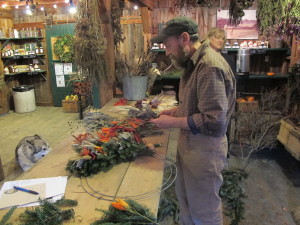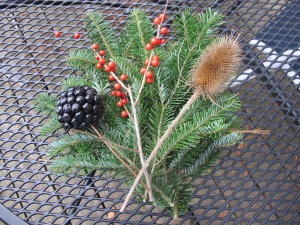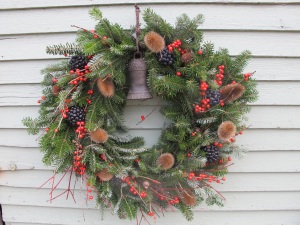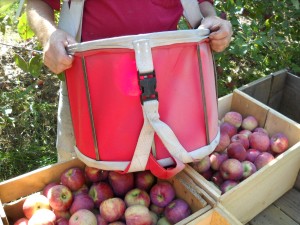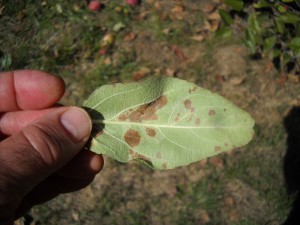Wreaths
Lights, decorated trees, carols on the radio and in the stores: all these say the holidays are here. For several years now I’ve been too busy (or too lazy) to create my own wreath, but this year I was inspired to make one. I saw some simply amazing wreaths made by Gary Hamel and Amy Franklin of Riverview Farm in Plainfield, NH (www.riverviewnh.com) and called Gary to see if I could come and watch them work. Later I made my own – and you can, too.
Gary is an artist and Jack-of-all trades. His mother, Alice, made a wreath for their front door every year using materials from their farm to celebrate the solstice and brighten the season. On a flyer for wreath workshops at Riverview Farm, Gary wrote that a wreath is ”the symbol of unending years. The evergreen boughs represent the continuing presence of life in winter’s deep sleep. The dried flowers are the memory of the season past, and the grasses and seeds are the presence of the year to come”. I like that.
The Franklins at Riverview Farm grow and collect materials for their wreaths all year. Prime among the ingredients are dried Thai peppers – some red, some yellow – which grow several to a stem. They hang them in the barn to dry and get ready for wreath season. Also available for use in wreaths are dried miniature ears of corn, stems of rye and decorative grasses, shallots, rose hips, dried flowers, cones, nuts and and dried leaves. As Gary said, “this is not your grandmother’s wreath.”
Gary explained that the four herbs of the advent season are rosemary, sage, lavender and thyme, so he likes to use them in wreaths, too. Fragrant herbs like those four and others such as Sweet Annie (a vigorous growing perennial in the Artemesia genus) smell great when making the wreaths, but probably aren’t noticeable to most people once they are on the front door.
Making a wreath is not tough work at all. First I went to a Christmas tree farm and got a “reject” – a balsam fir tree that would not normally be salable. I wasn’t sure how many branches I would need, so I lugged the whole tree home. It turns out that I only needed about five branches.
Balsam fir is probably the best tree for making wreaths, though Gary and Amy also mix in some cedar or pine in some of their wreaths. Spruce is also suitable, but a bit prickly to work with. Canadian hemlock is not suitable – the needles fall off too soon, even if kept cold.
I wanted some bright color for my wreath, so I put on my barn boots and headed off to a local swamp where I had seen the bright red berries of winterberry, our native deciduous holly (Ilex verticillata). Winterberry usually grows in standing water, and most years I get my feet wet, boots or not.
This year I got smarter: I brought my pole pruner. The one I use has a pistol grip like a pair of hand pruners which allows me not only snip off berry-laden branches, but also to grab the cut branches by squeezing gently on the handle. The one I use is made by ARS and sold by an orchard supply company in Massachusetts, OESCO (www.oescoinc.com).
Winterberry tends to drop its berries, but Gary Hamel told me how to prevent that: get a can of clear Rust-oleum paint and spray the branches. At the hardware store a helpful clerk suggested that of the various clear products, lacquer would work best as a glue, so that is what I used. When I made my wreath, only a few of the berries fell off.
I collected other dried plants for my wreath including goldenrod stems with galls, teasel (a weed with wonderful prickly seed pods), dried black-eyed Susan and bee balm stems, red-twigged dogwood and 2-inch spheres of blue-black berries of the wild vine, carrion berry (Smilax herbacea). I sprayed the carrion berries with the lacquer to keep them from falling off, too.
A key to a good wreath is making the stems secure. Buy a spool of green wreath wire from your local garden center or florist, and a wire wreath form. I used a double ring 18 inches in diameter. This year, instead of making bundles and then attaching them, I followed Gary’s technique of using one continuous piece of wire for the entire wreath, tying the bundles on as the wreath progressed.
First, I tied the wire securely onto the wreath form. Then I made and attached my greens and decorative elements. At the base of each bundle I made five tight loops of wire around the stems going one way, then another 3 or 4 turns going back the other. That made the greens very secure.
Each bundle I made started with 5 stems of balsam fir. Two were about 10 inches long, the other three were shorter. Then I placed a stem of winterberry in the middle, and added other elements. I alternated the various elements, some in one bundle, then skipping them in the next, repeating in the third. Only the red berries and fir were in each bundle. Each bundle should be about the size and shape of your hand.
It takes about 20 bundles of greens to complete a wreath. The only tricky part is at the very end, to attach the last bundle. I see why people use red ribbons at the top: not only to look good, but to cover up the inevitable gap. I didn’t have a ribbon, so I used a brass bell. Gary’s mom insisted that her wreath come off the door on February 2, Groundhog’s Day, also known as Candelmas. She unwound the wire and burned the greens. Me? I’ll keep it up as long as it looks good.
Henry is the author of 5 books. His website is www.Gardening-Guy.com/.
Apples!
I read my first piece of propaganda when I was eight, maybe nine years old. It was a biography of Johnny Appleseed. It was one of a series of library books, all with orange covers, large print, and just a few simple drawings. They were fascinating, every one of them. Johnny, I learned, was a happy-go-lucky sort who walked around America giving away apple seeds. Not so. Johnny was a businessman who sold apple seeds and seedlings so frontier folk could make hard cider and its distilled companion, applejack. Most of the apple trees back then were what we would call wild apples – those that we wouldn’t consider good eating apples.
Here’s my quick course on apples: any named apple variey today is genetically identical to all others of the same name. That’s right. All Macs or Cortlands are the same, genetically, as all other Macs and Cortlands. Before you buy a tree, someone has grafted scions (living twigs) onto root stock to produce a tree that will give you tasty apples of a named variety. Some nurseries even sell trees with 3 or 4 different varieties grafted onto one tree.
The roots affect whether your tree is full sized, mid-sized or dwarf. Most new apple varieties – Macouns, for example – are hybrids developed by apple researchers, tested and then propagated by grafting – not by seed. So don’t plant seeds from your favorite apple thinking the tree will be like the mother apple.
Apple trees are easy to grow – you should have one, or perhaps more. Not only that, one can grow good eating apples without using toxic chemicals, although most orchards use some chemicals to control apple scab and sometimes insect pests. Americans have grown very fussy about their food, demanding perfect fruit, unblemished by even a spot of blight, which makes the orchards spray. The home grower can eat organic fruit with a few small brown spots, or cut them out.
I recently visited Paul Franklin at his farm, Riverview Orchard, in Plainfield, NH; he has been growing apples for sale for over 25 years, and is a wealth of knowledge. One of my first questions to Paul was this: how do you know when an apple tree is ready to pick? It’s easy, he said. Just cut open an apple and look at the seeds. If they are tan to dark brown, the apple is ready. Paul added that some apples resist coming off the tree, even when they are fully ripe while others are easy to pick even when still green.
What about that film often seen on apples? It’s not a pesticide, Paul said, but Mother Nature at her best. It is a thin film of wax, which protects the apple. Polish it a bit, and the apple shines. Some apples have more wax than others.
This past spring many apple blossoms were damaged by a period of unusual warmth that was followed by a hard frost. The frost damaged the opening buds, so many of us lost all or most of our apples. I live in a cold spot and lost all mine. Paul Franklin’s orchard is near the Connecticut River, so the little bit of heat released by the water minimized his losses. If you are choosing a site to plant apples, remember that near the top a hillside is a good spot. Cold air is dense, and tends to slide down hill. Often only a degree or two can make the difference between success and failure.
I asked Paul about his favorite apples. He said that Cortland and Honey Crisps are two of his favorites. Honey Crisp is tasty and somewhat resistant to apple scab. Cortlands are great apples for both eating and making pies. Honey Crisp are great keepers – a customer of his picks a bushel of them, then stores them in a spare fridge for up to a year. If you do that, don’t store other vegetables in the fridge because apples give off ethylene gas, which prompts other veggies to age and go past their prime.
If you planted an apple tree recently be sure to protect the bark with a collar of quarter-inch hardware cloth (metal screening). An 18 inch square can be used to wrap around the base to keep meadow voles (voracious mouse-like creatures) from nibbling the bark in winter. If a vole eats bark all the way around a trunk it will kill the tree. Dig the screen in an inch to keep them from going under it. After 5-7 years the bark is thick enough that the hardware cloth is not needed.
What else can you do for your apple trees now? In order to minimize apple scab and other diseases, rake up the leaves under your trees. Scab overwinters on leaves. Mowing under trees helps, too – chopping up the leaves and helping them to break down. Young trees benefit by a little slow release organic fertilizer in the fall, but older trees do not need it.
So go pick some apples on a warm sunny fall day. Eat plenty, make a pie, save some for winter. And thank Johnny Appleseed – if you believe in the propaganda.
Henry Homeyer’s Web site is www.Gardening-guy.com. Henry’s upcoming kid’s fictional chapter book, Wobar and the Quest for the Magic Calumet, is just out. Check for Wobar at your local bookstore or go to henryhomeyer.com to learn more.



